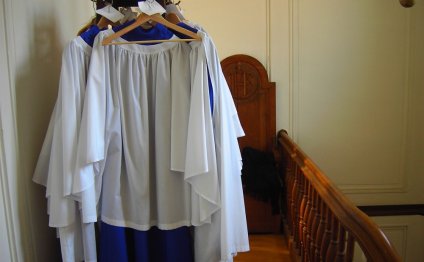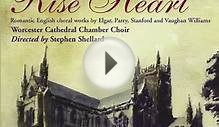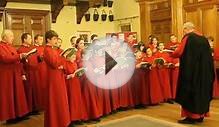
Anglican Choir robes
 Alb An alb, called a sticharion in Orthodox churches, is a plain, lightweight, ankle-length tunic with long sleeves. It is generally worn with a rope around the waist. The word alb is short for the Latin phrase tunica alba, which means white tunic; accordingly, albs are usually made of white or undyed fabric.
Alb An alb, called a sticharion in Orthodox churches, is a plain, lightweight, ankle-length tunic with long sleeves. It is generally worn with a rope around the waist. The word alb is short for the Latin phrase tunica alba, which means white tunic; accordingly, albs are usually made of white or undyed fabric.
In the first century, the tunic was the first article of clothing that you put on in the morning. Working-class people wore knee-length tunics, while older people and people with less active occupations wore ankle-length tunics. It was possible to wear more than one tunic at a time for warmth, but it was considered gauche to wear a tunic without a cincture.
The tunic was originally sleeveless. Greeks and Romans thought sleeves were barbaric because barbarians wore them. (The barbarians lived in colder climates.) Tunics did not acquire sleeves until the third century, when a Roman Emperor came back from a military campaign wearing a tunic with sleeves—much to the horror of the fashion mavens of the day. A modern alb has sleeves because we need to cover street clothing that has sleeves.
In the first century, most people wore a himation over their tunics. The himation was a rectangular garment that was wrapped around the upper body. The designs on the himation, as well as its color and quality, varied depending on the wearer’s sex, occupation, and social status. Because of the relatively precarious way it was worn and the way it hindered movement, people had to remove it when they were engaged in certain physical activities. For example, when blind Bartimaeus ran to Jesus in Mark 10:46-52, he threw off his himation. Matthew 9:20-22 tells about a woman who was healed when she touched the hem of Jesus’ himation. In Revelation 3:5, 3:18, and 4:4 people are given white himatia. Perhaps the writer of Revelation wanted us to think of people who had received a white tunic at their baptism now receiving an elegant and triumphant white himation to wear over it. The himation never became a church vestment, probably because as servants, the clergy would have to remove it anyway.
Scripture tells us that Jesus wore a himation over a tunic (‘tunic’ is χιτων in Greek) to the crucifixion. The soldiers tore the himation in four pieces, but because the tunic was woven in one piece, they cast lots for it. Jesus’ tunic would have been sleeveless and ankle-length—it was the same kind of tunic that the high priest wore when he entered into the Holy of Holies to atone for the sins of the people. Ancient writings from that period refer to seamless tunics, but the technology for weaving them that way was lost in the fall of the Roman Empire.
In the first four centuries of the Church, people were baptized in the nude. For propriety, they were baptized in three groups: men, women, and children; and female deacons baptized the women. When they emerged from the water, they were immediately clothed in a white tunic (a tunica alba, or alb ). For this reason, the alb is a reminder of baptism and a symbol of the resurrection on the Last Day.
Anyone who has a leadership role in worship can wear an alb and cincture, whether they are clergy or lay people. Only clergy wear a over the alb. Albs are increasing in popularity not only because they are ecumenical, but also because congregations are increasingly eager to conform to the practices of the ancient Church. In addition, a person wearing an alb is dressed like Jesus.
Amice An amice is a rectangular piece of cloth with religious symbols and two cords, one affixed to each front corner. It originated as a neck scarf, which was still its form and function in the first century. People sometimes also pulled it up to use it as a head covering. It became a vestment in the eighth century. Today, it is mainly in use in the Roman Catholic Church. When the priest is vesting (that is, putting on vestments), the amice goes on first. He puts the amice on his head, like a bonnet, then his . He pulls the cords around his torso, so they cross in the back, and ties them in the front. After he puts his on, he pulls the amice down around his neck so that it looks like a collar or a muffler.
When the priest is vesting (that is, putting on vestments), the amice goes on first. He puts the amice on his head, like a bonnet, then his . He pulls the cords around his torso, so they cross in the back, and ties them in the front. After he puts his on, he pulls the amice down around his neck so that it looks like a collar or a muffler.
Like all vestments, the amice has symbolic meaning as well as practical value. While it is temporarily on the priest's head, it symbolizes the helmut of salvation (Ephesians 6:17), and after it is pulled down, it symbolizes the burden he bears. Before Dr. John Breck invented Ph-balanced shampoo in the 1930s, people didn’t wash their hair very often, because washing your hair with soap doesn't produce happy results. As late as the 1950s, there were hair tonics and hair creams that made hair look fashionably greasy. Since the amice covers the priest’s hair while he is putting on his chasuble, it protects the chasuble from grease and hair-care products. After he pulls it down onto his shoulders, it serves as a neck scarf to protect his throat from the cold.
An amice is also known as a superhumeral, meaning “over the shoulders.”
Anglican Collar A style of with a wide, rectangular tab. A cassock is a plain, lightweight, ankle-length garment with long sleeves, but no hood. The cassock is a clerical, not a vestment. It serves as an undergarment for vestments, namely the (a type of ) and the .If the cassock has buttons down the center of the front, from the neck to the ankles, it is called a Roman cassock. If it is double-breasted, it is called an Anglican cassock.
Cassocks are worn by both clergy and lay worship leaders, with or without a surplice. Only ordained clergy wear a stole over the surplice.
Cassocks are most common in Anglican, Roman Catholic, and Orthodox churches. The cassock-and-surplice combination is very common in Anglican churches. Some choirs wear cassocks with surplices instead of robes.
Chasuble A chasuble, called a phelonion in Orthodox churches today, and a φελονης in 2 Timothy 4:13, is an ornate circular garment with a hole in the center for the wearer’s head. When worn, it reaches to the wearer’s wrists, so that if the wearer holds both arms straight out, the chasuble forms a semi-circle when viewed from the front or the back. The chasuble is the descendant of a first-century paenula that was worn as a coat by both sexes. Today it connotes solemnity and formality. The chasuble can be worn by the celebrant during a Eucharistic service. Sometimes the celebrant puts the chasuble on over other vestments as part of the Eucharistic ceremony. Chasubles are used in Lutheran churches, particularly outside the United States, as well as in Anglican and Roman Catholic churches. From the customs of the day, we can infer that Jesus most likely wore a chasuble at the Last Supper. The chasuble is always worn with a . Generally, the stole is under the chasuble. For us, the stole and chasuble combination is the equivalent of wearing a necktie and jacket. It is not appropriate to wear a chasuble in a service that does not include Communion (except for Good Friday and Holy Saturday services).
The chasuble is always worn with a . Generally, the stole is under the chasuble. For us, the stole and chasuble combination is the equivalent of wearing a necktie and jacket. It is not appropriate to wear a chasuble in a service that does not include Communion (except for Good Friday and Holy Saturday services).
The Roman Empire had two modes of execution: non-citizens were thrown to wild animals, but citizens were beheaded with the sword. Therefore when Paul says that he escaped the lion’s mouth in 2 Timothy 4:17, he means he had successfully proved his Roman citizenship. In 2 Timothy 4:13, most translations vaguely refer to a garment or a cloak, but in the Greek, Paul asks Timothy to bring him the chasuble he had left behind in Troas. The design of Paul’s chasuble would have made his status as a Roman citizen obvious to any witnesses to his execution.
Therefore, when the celebrant is dressed in a chasuble, he is dressed like a Christian martyr who is ready to have his head chopped off for Christ, or like Jesus presiding over the Last Supper.
Christus victor Christus victor is Latin for Christ the Winner. It is similar to a, in that it consists of a figurine of Jesus imposed upon a cross, except that the figure of Jesus is fully clothed, usually wearing a red over a white tunic (that is, an ), with uplifted and outstretched arms and a triumphant facial expression. It depicts the triumph of the Ascension over the suffering of the Crucifixion. Cincture A cincture, called a poias in Orthodox churches, is anything worn around the waist to gather or hold up clothing. Vestments often include cinctures made of cloth or rope. When a cincture is made of leather or plastic, or if it is used with street clothing, it is called a belt.Here’s a tip: If you have a small paunch, and you put the cincture around your waist, it will make you look like you have an enormous beer belly. If you put it at the level of your navel, it will look much better.
Clergy Shirt A clergy shirt is a clerical, not a vestment. There are two types: and . Though many people associate clergy shirts with the Roman Catholic Church, that is only because the their sheer size makes their clergy conspicuous. Clergy shirts (black shirts with white tabs or collars) are actually of Protestant origin. The Rev. Dr. Donald McLeod of the Church of Scotland (Presbyterian) invented the neck-band shirt style. Protestant clergy had been wearing white preaching bands for quite some time; McLeod combined them with the detachable collar that was in use at the time. The Roman Catholic Church did not adopt them as streetwear for clergy until later. They modified Rev. McLeod’s design into the tab-collar style. Clerical The term ‘clericals’ refers to the clothing and accessories that clergy wear as street clothes, such as a, which make it evident that they are clergy. The difference between clericals and vestments is that clericals are street clothes, while vestments are only worn during worship. Colors Cope A cope is an ornate cape-like garment worn by a bishop. In the ancient Church, bishops were generally elderly men who needed a cope to keep warm. The bishop removes the cope and puts on a chasuble to celebrate the Eucharist. Cotta A cotta is a type of . In general, it is better to forego the cotta and just wear the surplice. Cross (pectoral cross) Many people wear crosses around their necks as jewelry. If the cross is large enough to be seen from a distance and the chain is long enough to position the cross over the center of the chest, it is called a pectoral cross. Pectoral crosses are quite often worn over albs or cassocks, but seldom if ever over robes. While they look quite nice with vestments, they are too dramatic for street clothes. If you want to wear a cross with street clothes, use a small cross on a neck chain. Christians did not wear crosses or hang them on their walls until after crucifixion was no longer the standard method of capital punishment. Instead, the earliest Christians used the gesture of the .
Christians did not wear crosses or hang them on their walls until after crucifixion was no longer the standard method of capital punishment. Instead, the earliest Christians used the gesture of the .
You can see a pectoral cross over an alb or over a cassock and surplice.
Cross (sign of the cross) The sign of the cross is a pious gesture that must have originated in the first century, because it was a widespread practice in the second century. It is not a late innovation of the Roman Catholic Church, as many people imagine. It may be that early bishops applied chrism (anointing oil) by tracing a cross on the person’s forehead, and the gesture originated when people wanted to reaffirm their anointing afterwards by using their right thumb to trace the sign of the cross on their forehead. The gesture quickly developed into its modern form, where the right hand moves from the forehead to the chest, then from shoulder to shoulder. Eastern Christians cross themselves right to left, and Western Christians cross themselves left to right. It is customary to cross oneself at the beginning and ending of prayer (at the words “in the name of the Father, and of the Son, and of the Holy Spirit” ), before receiving Communion, and at certain points in the liturgy. It is common for the clergy to make the sign of the cross over the elements of the Eucharist as they are being consecrated, and over people and objects as they are being blessed. I always make the sign of the cross over the congregation when I bless them in the benediction at the end of the service. The sign of the cross is also helpful at times when you are moved to pray but at a loss for words. You can find out how to cross yourself. Crucifix A crucifix is a cross with a superimposed figurine. Crucifixes originated before the sixth century, at which time the figurine depicted Jesus symbolically as a lamb. As Christian art gradually began to depict Jesus as a human being rather than as a lamb, the figurine changed from a lamb to a fully dressed triumphant Jesus. The crucifix with a suffering Jesus became very popular in the west during a time when so many people were dying of the plague that disposing of corpses was the most pressing issue for local authorities. In those days of unrelenting grief, suffering, and sorrow, pastors spent most of their time conducting funerals. (Reread the lyrics of the hymn, Now Thank We All Our God, and ponder the fact that it was written by a pastor who buried dozens of plague victims each day.) Many of the more gruesome crucifixes from that era show Jesus dying from the grotesque final symptoms of the bubonic plague, including the contorted, purple face. Today, in our more comfortable times, such crucifixes strike us as grotesque or horrible, which was of course the point. Crucifixes made sense of all that suffering and dying. They were an important expression of faith that Jesus does not ask us to do anything He is not willing to do, and that He can overcome even the most horrible death. Because the plagues were largely in the west, crucifixes are not as common in Orthodox churches, and because the plagues were largely over by the time of the Protestant Reformation, many Protestants associated them with Roman Catholicism and did not use them; however, they are still common among Anglicans and Lutherans. Dalmatic In the first century, a dalmatic was an garment that the upper classes wore over their tunics. It is very much like a in shape, except that it is plain and not necessarily white. In the church, it is a garment sometimes worn by deacons. If the deacon is wearing a dalmatic, it can go either over or under the, but I think in most cases, it would look better with the stole on top. Dog Collar An Anglican nickname for the collar that accompanies a —it actually does look something like a flea collar, when you think about it! Epitrachilion See . Incense See . Mitre A mitre is a distinctive hat worn by a bishop. The word mitre comes from the Greek word mitra (μιτρα), which means headband. In the ancient Church, bishops were generally elderly men who needed a hat to keep their heads warm. Today the mitre is symbolic of the bishop’s office and it generally matches the bishop’s cope. Neckband Shirt A neckband shirt is a clerical, not a vestment. It is a type of shirt (or blouse, for female clergy) that has no collar, just has a thin band of cloth around the neck; hence the name. The shirt has a fly front; that is, a flap of cloth that covers the buttons that go down the front. Where you would expect to find a top button—the one you’d fasten before putting on a necktie—the neckband has two buttonholes that line up. There is also another button hole in the neckband in the center of the back.The wearer puts on the shirt, then sticks a collar stud through the button hole in the back of the neckband, then another collar stud through the buttonholes in the front to fasten the two ends of the neckband together under the throat. The white plastic collar has three small holes in it; one in the middle and one at each end. The wearer slips the center of the collar over the collar stud in the front, then wraps the two ends around the back and slips them over the collar stud in the back. The end effect is a circular collar that goes completely around the neck.
YOU MIGHT ALSO LIKE



Share this Post
Related posts
Children Choir robes
Ashbury A. This back opening design features contrasting yoke and sleeve trim. Prices range from $80 to $100* per children…
Read MoreCheap Choir robes
Those ubiquitous empty plastic beverage bottles seen almost everywhere are now being put to good use. Willsie Cap &…
Read More










